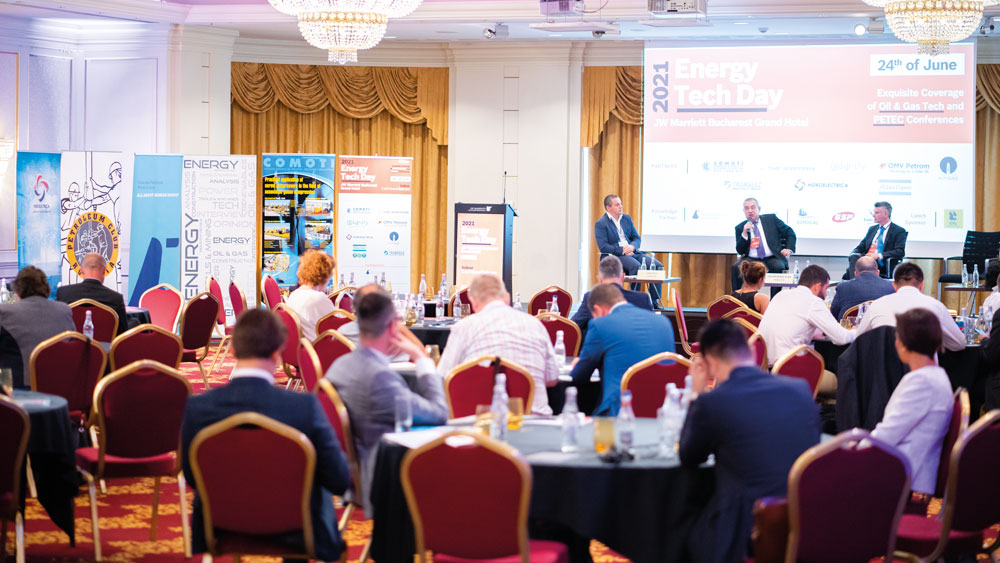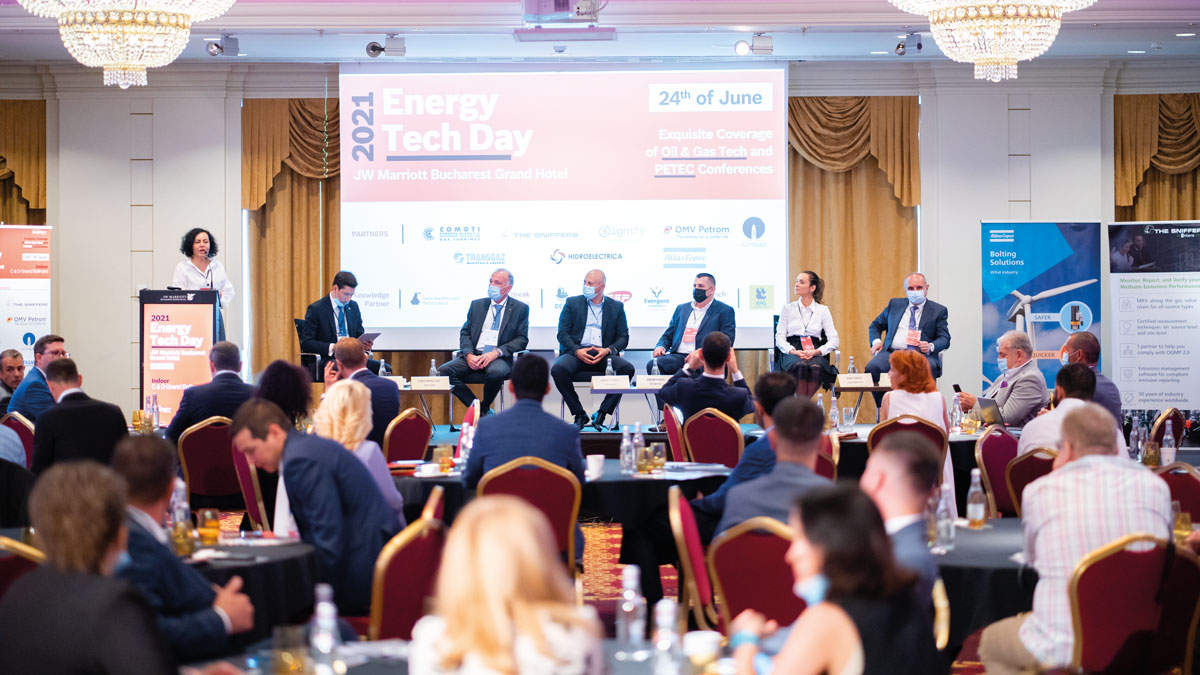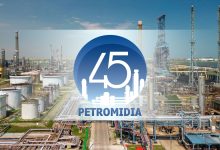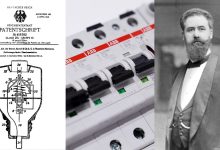Energy Tech Day 2021: Featuring Voices of Leading Experts and Highly Qualified Professionals
Energy Tech Day 2021, held on 24 June in Bucharest, united once again leading energy experts and highly skilled professionals to share their experiences on ground-breaking technologies, strategies, and investment programmes.
‘Prospects and Challenges in the New Digital Era: Managing GHG Emissions and Energy Efficiency’ was the main theme for this high-level conference.
The EU aims to be climate-neutral by 2050 – an economy with net-zero greenhouse gas emissions. This objective is at the heart of the European Green Deal (EGD) and in line with the EU’s commitment to global climate action under the Paris Agreement. Under the EGD, the European Commission announced a review of its energy and climate legislation to scale up emissions reductions and boost the deployment of renewables and energy efficiency. Energy efficiency is changing, with new digital technologies enabling greater control, optimisation, and analytics. Harnessing digital technologies to enhance energy efficiency will require new policies and business models.
The event brought together top national and international energy business leaders to address commercial, regulatory, geopolitical, and technical challenges impacting the future of the energy industry. The most important topics approached by the speakers, during the 3-session conference, were the European Green Deal challenges and opportunities; state-of-the-art technologies impacting each part of the value-added energy chain: sources, conversion, distribution, storage, usage; smart solutions to maximize efficiency, reduce costs and CO2 emissions; regulatory framework to stimulate innovation and investment; environmentally responsible energy uses; financing the industry.
SUPPORTING ROMANIA’S POST-PANDEMIC ECONOMIC RECOVERY
Niculae Havrilet, Energy Expert, MINISTRY OF ENERGY, emphasized the importance of energy efficiency, in all sectors of the energy industry, and therefore of economic efficiency, along with digitization. The deepest concern, at the moment, of EU funds and even of INECP, refers to building heating-cooling system and efficient thermal insulation of buildings. Another topical issue, hydrogen, is also on the European agenda. The latest scientific research shows that hydrogen storage is the most efficient electricity storage method available at today’s technological level. Hydrogen does not pose environmental risks, with the possibility to be used in heavy transport, in shipping, in electricity production; it will be a substitute for natural gas. When we talk about efficiency, we should focus on the area of hydrogen production and use, and as far as buildings are concerned to focus on homes with zero energy consumption for heating and cooling, the representative of the ministry pointed out.
The efforts of the European Union (EU) and Member States related to decarbonization and transition to a low-carbon and low-emission economy aren’t just about investments in renewables or energy efficiency measures, but also about encouraging digitization of the energy industry, this goal being the basis of reaching these decarbonization targets, pointed out Nagy-Bege Zoltan, ANRE Vice President. This is reflected both in the financing mechanisms promoted by the EU, which give an advantage to research, innovation and implementation of modern technical solutions, and in the energy policies lately promoted by the European Commission, he added. In the following period, investments in renewable sources will have a massive comeback in Romania, as INECP (Integrated National Energy and Climate Plan) also provides, through which we aim to reach a 30.7% share of renewable energy in the gross energy consumption in 2030, which involves the construction of about 7 GW of new energy capacities using renewable sources, in addition to retrofitting of existing renewable capacities, which in 2030 will have had 15-20 years of operation already. The first and most important challenge will be to integrate these new capacities in the national energy system, replace the polluting power plants based on fossil fuels, but controllable and predictable in terms of production, with the new uncontrollable renewable units but which ensure a reduction of greenhouse gas emissions. Digitization and the use of innovative technical solutions are the only way to achieve this now. Concepts such as Smart Metering, Smart Grid, electricity storage, Demand Response, consumer participation in the balancing market, virtual hubs, aggregate production or aggregate consumption, distributed production are solutions implemented and already used with success in many EU Member States, also allowed by the national legislation. Those who currently invest in digitization will very soon have an advantage in the market over the other competitors, Nagy-Bege Zoltan believes.
New Projects and Business Opportunities for Oil & Gas up to 2030
The first session of the Energy Tech Day 2021 was focused on new projects and business opportunities for oil & gas up to 2030. Catalin Nita – Executive Director, FPPG, reviewed, together with the speakers of the first panel, the main investments targeted by the industry in this period, also pointing out that natural gas has in Romania a very bright future. The role of the Romanian oil and gas industry and its contribution to budget revenues were also emphasized. Therefore, during 2017-2019, the largest oil and gas producing companies in the country (surveyed) generated 1.8% of GDP, i.e., approximately 50% of the contribution of the whole energy sector. Investments amounted in 2019 to RON 6.7bn, double compared to 2017, the equivalent of 16% of public sector investments. It is also worth mentioning Romania’s dependence on natural gas, which in 2019 reached 24%, compared to 2% in 2015, the growth trend maintaining in the future.
The importance of gas in energy transition and reaching climate targets was the focal point of the presentation of Christopher Veit – Member of the Executive Board Responsible for Upstream, OMV PETROM. His presentation included the main activities, objectives, projects, and investments envisaged by the company in the following period. OMV Petrom’s interest in the exploitation of Black Sea gas resources was reiterated, as well as the opportunities arising from this situation for Romania. Black Sea potential can give Romania the chance to become the largest gas producer in the EU. Natural gas is also a solution for Romania to reduce its carbon emissions and support the country in reaching the environmental targets, considering the multiple possibilities of use, from heating and electricity to mobility. The successful gas projects in the exploration and production sector could open the way for the development of projects in related industries, from gas transmission and distribution to the chemical and petrochemical products sector or turning natural gas into electricity. An alarm signal was sounded regarding cloud technologies. Due to restrictive legislation on working with petroleum data and information, local companies cannot use cloud technologies for their processing, although easy access to data improves the efficiency of the industry and, consequently, brings additional revenues to the state budget. Last but not least, the OMV Petrom representative emphasized the importance of a stable, predictable and competitive legislative framework related to the upstream sector, that would encourage the development of Black Sea resources.
The Black Sea has a huge potential, according to Robert Chirca – Onshore Operations Manager, GSP HOLDING, who brought to the audience’s attention the synergies between offshore platforms that exploit natural gas and wind parks, which would add value to the whole area, thus being able to contribute to Romania’s energy independence. GSP applauds the visionary project of building the first offshore wind farm in the Black Sea basin. The company operates a complex structure of bases, each with its own capabilities and objectives. Their operational structures are integrated in an intelligent work-system, that provides a robust support network for clients. GSP has the capabilities to manage, plan, develop, install, and operate a major wind farm project, Robert Chirca claims. He also revealed some key important factors to analyse when embarking on a wind farming offshore project – power, depth, distance, costs, foundation type. Constanta can become an energy hub in Southeast Europe, benefiting from all the necessary facilities. But for these things to be possible, a clear plan and short-, medium- and long-term strategies are needed, the representative of GSP Holding also mentioned.
We found out from Adrian Staicu – Regional Manager SE Europe, THE SNIFFERS, how the gas sector can approach its methane emissions management programs efficiently in compliance with OGMP (Oil and Gas Methane Partnership) 2.0. He revealed the most important steps taken in terms of reporting against OGMP 2.0, inventory, activity factors, emission factors. He reminded that methane warms the planet 84 times as much as carbon dioxide over a 20-year period; methane remains in the atmosphere for about 12 years; and globally, over 60% of total methane emissions come from human activities. He also underlined that reducing anthropogenic methane emissions is the only and necessary way to avoid a 2oC increase by 2050. On November 23, 2020, oil and gas industry committed to new framework to monitor, report, and reduce methane emissions. Recently, EU Commission announced a legislative proposal to make the measurement, reporting and verification (MRV) of all energy-related methane emissions mandatory (planned for 14 December 2021). It remains to be seen what measures the companies in the industry will adopt to align to the imposed regulations.
Vasile Carstea – General Manager, DEPOGAZ, delivered a presentation on prospects for the development of underground gas storage facilities in the context of the European transition towards a clean energy. DEPOGAZ is a modern company with a rich experience in underground gas storage. It is the main storage operator in Romania with a share of approximately 90.23% of the total active storage capacity of Romania. As operator of underground gas storage facilities, DEPOGAZ has two important objectives: to increase the underground gas storage capacities; to increase the daily withdrawal capacity from its underground storage facilities. To increase the underground storage capacities, DEPOGAZ has planned, on one hand, modernization works to increase the pressures of the storage facilities close to the initial pressures of the fields, this resulting in an increase in the capacity of the current storage facilities. At the same time, DEPOGAZ plans to develop new underground storage facilities in other regions of the country. As for the increase of the daily delivery capacity, DEPOGAZ is carrying on modernizing projects on the existing storage facilities, so that in the near future, the maximum withdrawal capacity will increase from 30 million m3/day to approximately 42 million m3/day.
Oana Ijdelea – Partner, IJDELEA MIHAILESCU, pointed out the essential role of natural gas in energy transition. She outlined how to cover the way from coal to RES via natural gas. Summarizing, this could be possible through integrated approach and implementation; adequate and coherent legal framework; predictability; stability; transparency; realizing the offshore gas potential; accessing EU money; digitalization; power grid development.

Clean Energy for Sustainable Development
Carbon neutrality was defined as a target for 2050 and for the European Union, a goal stipulated in the European Green Deal. In Romania, decarbonization of the energy sector is based to a great extent on the support provided by the European Green Deal. Accelerating transition to clean energy is the economic objective necessary in the context of current CO2 prices, of the price of renewable technologies, of European funds and a sustainable energy mix. For the decarbonization of the energy sector and reaching the targets established in the agreement, several European funding mechanisms were established. They include the Just Transition Fund, through which Romania has EUR 1.95 billion allocated, non-reimbursable funds. At the same time, the energy sector will benefit from an allocation of approximately EUR 1.6 billion through the National Recovery and Resilience Plan (NRRP). Moreover, Romania will receive financial support of EUR 80 billion from the European Union for economic recovery, pointed out Iulian Harpa – Managing Partner, HIM PUBLIC AFFAIRS.
In Romania, the research – development activity is a national priority and has a decisive role in the sustainable economic development strategy. INCDT COMOTI (Turbine Engines Research and Development Institute) is the only unit in Romania specialized in development and integration of scientific research, constructive and technological design, manufacturing, experimentation, testing, technological transfer, and innovation in the field of aviation turbine engines, gas turbine industrial machines and high-speed blade machines. As the institute is dedicated for energy saving, its major objectives are development of Romanian industrial gas turbines (1.5-5.4 MW); highly efficient generation of electric and thermal power with gas turbines (CHP); highly efficient centrifugal and screw compressors for air and natural gas; renewable energy (biomass gasification for industrial GT, wind turbines, biofuels). INCDT COMOTI capabilities include design, 3D modelling, CFD/numerical simulation, stress & vibrations analysis, automation of energetic groups, general revisions, service, maintenance, dynamic balancing, inspection and oil analysis, compressors test bench, Leonard Trifu – Marketing Manager within the company, mentioned. For example, INCDT COMOTI implemented the 1st RO cogeneration power plant (electric and thermal with gas turbines) in cooperation with PRATT & WHITNEY CANADA.
Sustainability is also essential for the SIGNIFY objective, not just through the innovative green products that improve people’s lives, but also in the way the company acts, said Razvan Copoiu – CEO SIGNIFY Romania & South-East Europe. Signify’s objective is to tap the amazing potential of light for a brighter life and a better world. With a history of over 125 years, Philips was founded as a lighting company, being the first to sell the light bulb. The company that paved the way for innovations in LED and connected lighting systems and services changed its name from Philips Lighting to Signify in 2018. The global brand for the Internet of Things platform and connected lighting systems is Interact, a platform designed to manage the data collected from the growing number of light points, sensor devices and connected systems. Based on cloud, highly secure and scalable, Interact uses sophisticated and modern data management and processing capabilities, including machine learning, to make sense of all types of data and bring value beyond lighting. To reduce the carbon footprint in Romania, the ‘Green Switch’ program of smart ledification from Signify means approx. 700 GWh in energy savings; approx. EUR 75 million in energy bill savings and approx. 250,000 tons of CO₂ reduction in the carbon footprint, added Razvan Copoiu, who also presented the most important lighting projects of the company successfully implemented in Romania.
Siemens Energy’s presentation on deep decarbonization with hydrogen and sector coupling highlighted instant ways to reduce the CO2 footprint and attractive use cases for hydrogen by 2030. Sector coupling is the key lever for decarbonization of all end user sectors, showed Petru Ruset – Managing Director, SIEMENS ENERGY ROMANIA. He also pointed out that if scaled up with the right regulatory framework, clean hydrogen costs can fall faster than expected (according to Hydrogen Council, McKinsey ‘Hydrogen insights report 2021’). But lower renewable costs are not enough: for low-cost clean hydrogen production, value chains for electrolysis and carbon management need to be scaled up. Thus, a further step-up of public support is required to bridge the cost gap, develop low-cost renewable capacities and scale-up carbon transportation and storage sites. Projections show that renewable hydrogen production costs could decline to USD 1.4 from 2.3/kg by 2030, depending on differences between optimal and average regions. The representative of Siemens Energy also mentioned some of the company’s most important projects: Energiepark Mainz – World’s largest PEM electrolysis facility in 2015, Haru Oni pilot project – Worldwide first integrated plant to produce climate neutral e-fuel from wind and water, H2FUTURE – a European Flagship project for generation and use of green hydrogen.
The energy sector is undergoing a huge change. Not only is there a transition from fossil fuel sources to clean renewable sources, but all energy sector operations need to increase productivity and reduce costs to remain competitive. This is driving demand for smart bolting solutions that can increase operational efficiency in areas such as faster process times, less bolted joint failures, and optimized service costs. Atlas Copco, a world leader in the supply of industrial compressed air equipment and solutions, is developing innovative new solutions that are enabling Industry 4.0 to be applied not only in the factory but also in the field. Among others, the company offers a complete range of industrial and intelligent bolting tools including hydraulic torque wrenches, bolt tensioners, and continuous rotation tools for all controlled bolting needs. The smart solutions proposed by the company were presented by Lukas Maly – Product Manager, ATLAS COPCO TOOLS EASTERN EUROPE within the Smart connected bolting presentation: Taking the smart factory to the field. With the introduction of smart tooling, Atlas Copco is looking to drive the transition of the energy industry by delivering the bolting transformation.
In the context of a climate neutral Europe by 2050, electromobility could be a part of the solution, Daniel Pintilie – Founder and CEO, WATTO STATIONS, affirmed. He talked about electric cars and how they could become a risk or a great opportunity for the national energy system in the coming period. What will happen when, in the very near future, millions of electric cars charge their batteries at the same time, from the electrical network, without it being designed and prepared for such a thing? In his opinion, a major problem is the lack of ultra-fast charging. In this regard, WATTO offers the fastest, the easiest and the most convenient charging services in the market, Daniel Pintilie claims. While we see a worldwide acceleration of infrastructure investments, WATTO solution is an integrated network of ultra-fast charging stations across Central-Eastern Europe. Thus, integration of e-mobility into a smart energy system would be the path to carbon neutrality, Daniel Pintilie concluded.

Most Ground-breaking Technologies Transforming the Energy Lifecycle
HIDROELECTRICA’s point of view on opportunities and risks in the digital era was revealed by Cristian-Nicolae Stoina – Member of the Supervisory Board. As a 100% clean energy producer – Hidroelectrica faces, as most energy companies, various problems related to digitization and green transition. In his presentation regarding the impact created by environmental protection on company’s activities, Cristian-Nicolae Stoina highlighted a number of advantages and disadvantages. The pandemic, but also acceleration of digitization, have generated a partial adaptation of the company to the new conditions. The solution for Hidroelectrica was to diversify production. While walking away from inefficient production capacities, the company purchases private production capacities, an example being the takeover of Crucea Wind Farm, with an installed power of 108 MW. In turn, the expert points to the risks related to personnel education and training adaptation to the digital era. As he points out, human force remains the most important component, and the next step in acquiring IT skills will be very costly, especially as there is also the risk of a massive redundancy. In other news, Hidroelectrica is preparing itself for integration in the European energy systems and plans to export electricity to the EU, Cristian-Nicolae Stoina also said.
For EXIMPROD GRUP, without a doubt, the future of energy is digital, states Sabin Posea – Business Development Director. Founded in 1994, with a worldwide presence, the company portfolio comprises manufacturing of electrical products from 0.4 to 400 kV, including equipment for railway; SCADA systems, automation and smart grid, software development, IoT, IioT; turnkey projects, complex energy projects rehabilitation or new installations; development, consulting & maintenance of projects in the field of renewable energy. The group is manufacturer for hundreds of products and equipment, combining and adapting them in order to help customers save resources. Its portfolio is perfectly designed for the safety, efficiency, resilience and reliability of the energy transmission and distribution grids. From the design phase until commissioning, Eximprod Grup team works to support customers in order to achieve their business goals. Their main objectives are to provide safe and environmentally friendly products and services and to conduct the operations responsibly.
Stefan Baciu – Country Manager, SAS ROMANIA & REPUBLIC OF MOLDOVA, brought forward advanced analytics for energy & utilities. According to him, 90% of the Fortune 500 utilities rely on SAS, which began helping utilities make decisions using data in 1976. There are 560 energy companies using SAS around the world, he added. Also, SAS is recognized as the number 1 analytics brand in utilities (according to Utility Analytics Institute). Stefan Baciu showed the capabilities of the SAS Platform for the Digital Utility. There are numerous related benefits that can result from using Asset Analytics: fewer failures and less downtime planned and unplanned across sites and assets; better equipment efficiency and higher overall quality; the ability to accurately predict outages before they occur, while running assets at peak performance. Customer Analytics offer meaningful, satisfying customer interactions across channels, top rated protection against revenue losses, and cost-effective management of customer outreach programs, sites, products, and rates. Credit and collection optimization minimizes bad debt and increases cash flow. As for Portfolio Analytics, these control customers’ market, credit, and regulatory risks, identify new opportunities and use that insight to make decisions with confidence. With analytics from SAS, you can fully optimize your portfolio, pointed out Stefan Baciu.
We thank all our Partners, Sponsors, Speakers & Attendees for their collective efforts during these challenging times. With the Covid-19 situation, we stand by the industry, as we face uncertain times ahead.
The Energy Tech Day 2021 benefitted from the support of: OMV Petrom, Romgaz, INCDT Comoti, Transgaz, The Sniffers, Signify, Hidroelectrica, Atlas Copco, FPPG, Eximprod Grup, Depogaz, GSP, Evergent Investments, CNR-CME, ACUE, PCOR.







